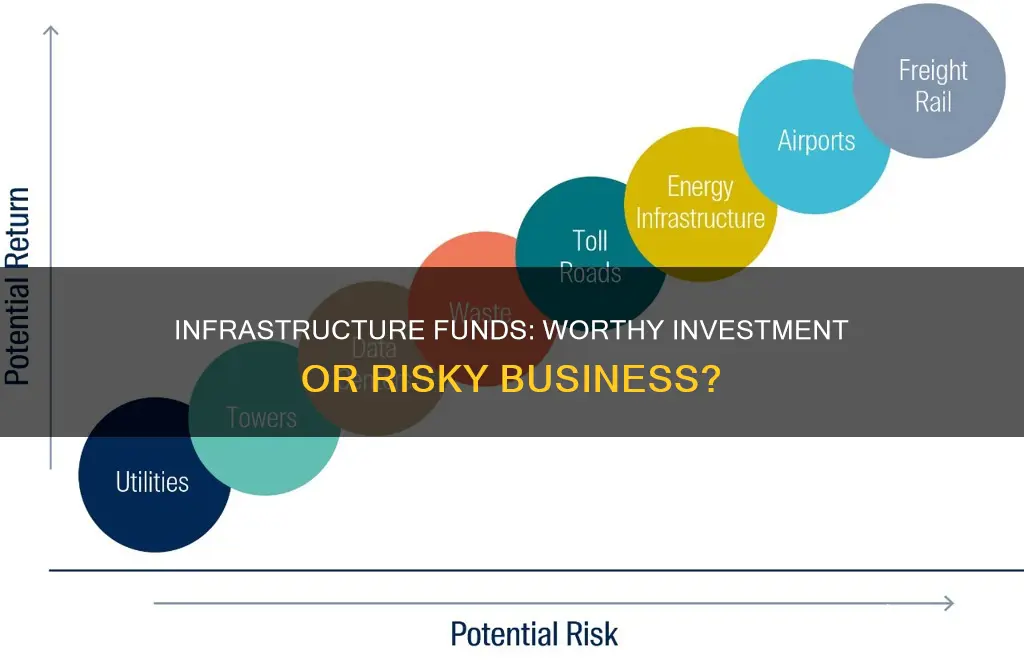
Investing in infrastructure funds is a complex decision that requires careful consideration. Infrastructure funds have traditionally been stable, offering low-maintenance investments with strong, consistent returns. However, recent economic shifts, including significant inflation, rising interest rates, and the impact of the COVID-19 pandemic, have disrupted this stability. The energy transition and advancements in digitization have also introduced new dynamics and risks to existing infrastructure investments.
Despite these challenges, infrastructure funds remain a compelling choice for investors due to their countercyclical nature, non-correlation with the stock market, and perceived lower risk. The private infrastructure market has more than tripled in size since the global financial crisis, attracting significant interest from investors.
When considering investing in infrastructure funds, it is important to assess the diverse strategies, structures, and risks associated with these funds. Infrastructure funds span a wide range of sectors, strategies, and geographies, offering various opportunities for investors. However, infrastructure investments are also susceptible to project delays, cost overruns, environmental compliance issues, and political uncertainties, which can affect performance.
In conclusion, while infrastructure funds have the potential to deliver superior returns, they also carry significant risks. Investors should carefully evaluate these risks, conduct thorough research, and seek expert advice before making any investment decisions.
| Characteristics | Values |
|---|---|
| Risk | Lower risk than other investments, but investors still need to deal with the impact of structural shifts in the economic environment. |
| Returns | Strong, consistent returns, even through chaotic periods. |
| Inflation | Strong inflation linkage. |
| Market Performance | Not correlated with the stock market. |
| Energy Transition | Riding the wave of the energy transition and digitalization. |
| Government Support | Buoyed by unprecedented government support. |
| Strategies | Diversity of strategies, spanning myriad sectors, strategies and geographies. |
| Debt | Infrastructure debt is drawing particular interest. |
| ESG | Natural fit for ESG investing, but ESG risks must be considered. |
| Structures | Diversity of structures, including unlisted and listed funds. |
| Investors | Appeal to high net worth and retail capital. |
| Secondaries | The market for infrastructure secondaries is heating up. |
What You'll Learn

Infrastructure funds are a risky bet
While infrastructure funds have traditionally been stable investments, they are not without their risks. The energy transition, for example, has introduced new dynamics to existing infrastructure investments, and investors need to be cautious about the risk/return profile of their portfolios.
Infrastructure as a sector is cyclical and dependent on economic growth. The revenues of infrastructure companies can fluctuate with the economic cycle, and this is reflected in the performance of infrastructure funds. There have been periods of underperformance, with negative returns in nearly half of the years in the last decade. For instance, the period from January 30, 2020, to April 3, 2020, saw infrastructure funds falling by an average of at least 35%.
Infrastructure funds are also susceptible to project delays, cost overruns, environmental compliance issues, and political uncertainties, which can affect the performance of the underlying companies. The long gestation periods of infrastructure projects can result in lagged returns for investors.
Additionally, some investments that were once considered low-risk may now carry more risk than is currently understood. For example, entire fuel sources and related assets are being phased out of the economy, impacting the risk profile of certain infrastructure assets.
Furthermore, the diversification benefits of infrastructure funds may be limited. The stock-picking skills of a fund manager play an important role in the performance of infrastructure funds, and investors should not rely solely on past performance when selecting a fund. It is crucial to consider the fund manager's track record, portfolio composition, volatility, and historical performance during downturns.
Given these risks, infrastructure funds should be approached with caution. They can be a part of an investor's satellite portfolio but should not exceed a certain percentage of the total portfolio. Investors in infrastructure funds need to be patient and accept potential periods of underperformance and high volatility. These funds may be suitable for those with a high-risk appetite and a long-term investment horizon.
Strategies to Cease Mutual Fund Investments: A Guide
You may want to see also

Infrastructure funds can be part of a satellite portfolio
Infrastructure Funds: A Risky but Rewarding Investment
A Satellite Portfolio
Infrastructure funds can be a part of a satellite portfolio, but they should not exceed 10% of the total portfolio. They are best suited for investors with a high-risk appetite who can accept long periods of underperformance and high volatility. The performance of infrastructure funds is closely tied to the economic cycle, so they are susceptible to downturns. However, they can offer superior returns and are a good option for those who want to invest in "real assets".
A Cyclical Sector
Infrastructure funds are exposed to the cyclical nature of the infrastructure sector. When the economy is down, the revenues of infrastructure companies tend to decrease, leading to swift declines in the value of infrastructure funds. On the other hand, they can also rise swiftly, and their year-on-year returns can vary considerably. This makes it important for investors to make calculated bets and be prepared for volatility.
A Long-Term Investment
Infrastructure funds are a long-term investment option. The projects in this sector have long gestation periods, and orders in the pipeline take time to convert into revenues. This means that investors need to be patient and accept periods of underperformance. However, infrastructure funds have the potential to reward patient investors handsomely.
A Diverse Asset Class
Infrastructure is a diverse asset class, spanning various sectors, strategies, and geographies. It includes essential services such as energy provision, transportation, and digital infrastructure. The funds range from lower-risk core and core-plus funds to higher-risk value-add and opportunistic funds. Infrastructure debt is also attracting interest due to its stable cash flows and lower historical losses.
ESG Considerations
Infrastructure funds have a natural fit with ESG investing due to the focus on the transition to cleaner energy. However, it is essential to carefully consider and disclose the ESG risks associated with infrastructure investments, such as environmental hazards.
A Smart Guide to Investing in Low-Fee Index Funds
You may want to see also

Infrastructure funds are impacted by economic growth
Economic growth can have a significant impact on infrastructure funds, and this relationship can be influenced by various factors, including the nature of the infrastructure projects, the timing and targeting of the investments, and the broader economic context.
The Positive Impact of Economic Growth on Infrastructure
Economic growth can have a positive impact on infrastructure funds by increasing productivity and output. Infrastructure investments, such as transportation, utilities, and environmental projects, can lead to higher productivity by providing essential services and improving efficiency. This, in turn, can result in higher wages and increased private capital investment, contributing to economic growth.
The Role of Government Spending
Government spending on infrastructure can stimulate the economy and boost gross domestic product (GDP). The "multiplier effect" of government spending means that each dollar invested can create additional private-sector spending, leading to a larger overall impact on the economy. However, the effectiveness of infrastructure spending as a stimulus depends on its timeliness, targeting, and temporary nature. Infrastructure projects often face implementation delays, which can reduce their ability to provide timely stimulus during a recession.
Negative Impacts and Limitations
While infrastructure spending can have positive effects, there are also potential negative consequences. If infrastructure projects are rushed without proper planning, they can have long-lasting negative impacts on regional economies. Additionally, if infrastructure is built solely for economic stimulus rather than addressing genuine regional needs, it could cause significant negative long-term effects.
Furthermore, the effectiveness of infrastructure spending as a stimulus depends on the broader economic context. During periods of high inflation, increasing interest rates, declining equity markets, and the threat of recession, infrastructure investments may still be better equipped than other investments to withstand such pressures. However, investors need to carefully scrutinize their portfolios and manage the risks associated with structural shifts in the economic environment.
Balancing the Impact
To balance the positive and negative impacts of economic growth on infrastructure funds, policymakers must consider the following:
- Timeliness: Infrastructure projects should be planned or already in progress to ensure timely completion and stimulus during a recession.
- Targeting: Infrastructure spending should be directed towards regions severely hit by the recession and industries impacted by the downturn, such as construction and heavy manufacturing.
- Sustainability: Infrastructure investments should not lead to unsustainable government debt or crowd out private investment spending.
- Political Considerations: Infrastructure spending should be based on actual public need rather than solely political or electoral considerations.
In conclusion, infrastructure funds are indeed impacted by economic growth, and a range of factors influence the nature and extent of this impact. While infrastructure spending can stimulate the economy and boost productivity, it must be carefully managed and targeted to ensure positive outcomes and avoid potential negative consequences.
Index Funds: Investing via Apps
You may want to see also

Infrastructure funds are a good fit for individual investors
Infrastructure funds have traditionally been a stable investment, offering low-maintenance investments with predictable risk profiles and strong, consistent returns, even through chaotic periods. They are a good fit for individual investors, especially those who are new to private markets.
Infrastructure funds are a compelling choice for investors due to their countercyclical nature, non-correlation with the stock market, and perceived lower-risk profile. The asset class has a strong inflation linkage, making it a safe port in challenging macroeconomic conditions.
The infrastructure sector includes companies that build and maintain major projects and systems such as roads, bridges, railways, and electricity systems. These "real assets" are essential services that are highly valued by society and are attractive to investors.
Infrastructure funds span the entire risk-reward spectrum, from lower-risk, lower-return funds to higher-risk, higher-return funds. Lower-risk funds tend to be open-ended with periodic redemption rights and derive their returns from the income generated by assets, while higher-risk funds have a closed-end structure and derive returns from capital appreciation.
Infrastructure debt is also an attractive option, as it offers exposure to investments that provide essential services with high barriers to entry, resulting in long-term stable cash flows that are relatively immune to the macroeconomic environment.
In recent years, the infrastructure investment sector has been shaken up by revolutions in energy, mobility, and digitization, introducing new types of investments and changing the risk profiles of existing investments. For example, the phase-out of fossil fuels and the rise of electric vehicles have impacted the risk profile of gas pipelines and fuel distribution services.
Despite these changes, infrastructure funds continue to offer ample opportunities for investors, including individual investors, to earn superior returns. However, it is important to note that infrastructure cycles are prone to project delays, cost overruns, and political uncertainties, so calculated bets and a long-term perspective are crucial.
Small-Cap Mutual Funds: Strategies for Smart Investing
You may want to see also

Infrastructure funds are impacted by the energy transition
The energy transition is providing numerous infrastructure opportunities as the world moves from hydrocarbons to renewable energy sources. However, challenges remain, indicating that renewables and conventional energy sources will need to coexist and work together on the road to Net Zero.
The energy transition is well underway, with solar and wind generation now accounting for over 10% of global power generation, up from virtually zero a decade ago. This shift has been driven by declining costs of renewables and broad political and regulatory support to decarbonize. More than 70 countries have signed Net Zero pledges, accounting for about 76% of global emissions.
As a result, infrastructure companies, particularly electric utilities and renewable developers, are poised to benefit from the commercial opportunities presented by the transition. However, there are several challenges and risks associated with the energy transition that impact infrastructure funds and investors.
Challenges and Risks
Capacity Factors
The availability of renewable energy sources like solar and wind is unpredictable and depends on weather patterns. This results in low and unpredictable capacity factors, making power production less reliable compared to conventional generation methods.
Supply and Demand Imbalances
The retirement of conventional power generation methods coincides with increasing power demand due to the electrification of transportation. Utilities must balance decarbonization efforts with ensuring a stable supply of energy to meet rising demand.
Resource Availability
The transition to renewable energy heavily relies on metals such as copper, polysilicon, silver, zinc, and lithium, which are critical for renewable energy infrastructure and battery storage construction. These resources are often mined in regions with geopolitical instability, such as China and Russia, posing supply chain risks.
Land Use
Constructing new renewable energy resources, such as wind and solar farms, requires significant land areas, and finding optimal real estate for these projects can be challenging.
Cost Inflation Risk
While renewable energy sources may have lower operating costs, there are higher upfront costs associated with mass adoption, including the need for new transmission infrastructure. Additionally, the world will need more total generation capacity to support the same level of energy demand due to the intermittent nature of renewable energy production.
Opportunities for Infrastructure Funds
The energy transition presents several investment opportunities for infrastructure funds, particularly in the following sectors:
Electric Utilities
Electric utilities will be significant owners of renewable generation capacity and will be responsible for upgrading and modernizing the electric grid to accommodate new energy sources. This will create substantial investment opportunities and higher earnings potential for the sector.
Midstream Energy
Midstream energy companies can expand pipeline infrastructure networks, providing cash flow certainty for investors. Additionally, they can explore opportunities in renewable natural gas (RNG) and hydrogen transportation, although these are still in the early stages.
Carbon Capture, Utilization, and Storage (CCUS)
Midstream companies investing in CCUS technologies can capture carbon dioxide emissions, preventing them from entering the atmosphere, and either storing them underground or utilizing them to create low-carbon fuels.
While the energy transition creates challenges, it also presents infrastructure funds with opportunities to invest in a sustainable, long-term financial opportunity. Active fund management and a proactive approach to deal sourcing and portfolio construction will be crucial for investors to navigate the risks and capture the emerging opportunities in the energy transition.
Equity-Free Investment Strategies: Diversifying Your Portfolio
You may want to see also
Frequently asked questions
Infrastructure funds are investments in companies that build and maintain major projects and systems such as roads, bridges, railways, and electricity systems. Infrastructure as a sector is cyclical, and revenues of infrastructure companies depend on economic growth.
Infrastructure cycles are marred with project delays, cost overruns, environmental compliance issues, and political uncertainties, which could affect the performance of the underlying companies.
Infrastructure funds have the potential to earn superior returns. They are also a good fit for individual investors that are beginning to dip their toes into private markets, presenting the potential for consistent returns.
When selecting a fund, investors should consider the fund manager's track record, portfolio composition, volatility, and performance during periods of downfall.
Examples of infrastructure funds include SPDR S&P Global Infrastructure ETF (GII), iShares Global Infrastructure ETF (IGF), and iShares U.S. Infrastructure ETF (IFRA).







